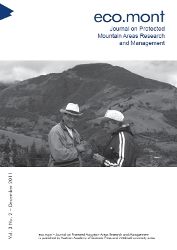
Eco.mont Vol. 3 Nr. 2, pp. 53-58, 2011/12/01
Journal on Protected Mountain Areas Research and Management

Our paper starts by sketching the historical and cultural background as well as characteristic features of the landscape around the venue of the 2014 Winter Olympics. It continues by pointing out spatial aspects of ecology, economy, demography and culture in the run-up to the olympics as well as the social tensions that have already emerged in this context and the potential for future conflict. Greater Sochi has a tradition as a spa and holiday destination that goes back to the foundation of the Soviet Union. The Olympic Games add the winter season to the existing tourist spectrum. At the same time, they provide the Moscow government with an opportunity for a new international positioning. A key problem is the exclusion of the local population from the preparations. This is most apparent in the resettlement of inhabitants from Imeritinska Bay (Olympic Village). Moreover, the games are held inside a national park area, albeit in a zone that permits leisure activities. The games will, however, stay largely clear of the territory of the biosphere reserve and at most affect it at the edges.
Keywords: XXIIth-Winter-Olympics Russia Caucasus Sochi